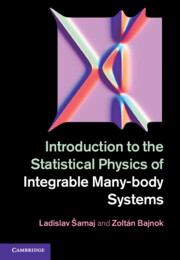Book contents
- Frontmatter
- Contents
- Preface
- PART I SPINLESS BOSE AND FERMI GASES
- PART II QUANTUM INVERSE-SCATTERING METHOD
- PART III QUANTUM SPIN CHAINS
- PART IV STRONGLY CORRELATED ELECTRONS
- 18 Hubbard model
- 19 Kondo effect
- 20 Luttinger many-fermion model
- 21 Integrable BCS superconductors
- PART V SINE–GORDON MODEL
- Appendix A Spin and spin operators on a chain
- Appendix B Elliptic functions
- References
- Index
20 - Luttinger many-fermion model
from PART IV - STRONGLY CORRELATED ELECTRONS
Published online by Cambridge University Press: 05 June 2013
- Frontmatter
- Contents
- Preface
- PART I SPINLESS BOSE AND FERMI GASES
- PART II QUANTUM INVERSE-SCATTERING METHOD
- PART III QUANTUM SPIN CHAINS
- PART IV STRONGLY CORRELATED ELECTRONS
- 18 Hubbard model
- 19 Kondo effect
- 20 Luttinger many-fermion model
- 21 Integrable BCS superconductors
- PART V SINE–GORDON MODEL
- Appendix A Spin and spin operators on a chain
- Appendix B Elliptic functions
- References
- Index
Summary
Low-temperature properties of 3D interacting fermion systems are well described by Landau's theory of Fermi liquids; for reviews see, e.g. [183, 184]. It involves only excitations of the system around the Fermi surface on energy scales small compared to the Fermi energy. Excitations are well described by quasi-particles which are in one-to-one correspondence with the bare particles. The bare-particle interaction does not break the qualitative picture of non-interacting system, but renormalizes the dynamical characteristics (the effective mass and the pair interaction) of quasi-particles. Within the microscopic Green function formalism, the existence of quasi-particles is equivalent to assuming that the self-energy correction Σ(k, ω) is regular (has only short-range contributions in time and space) close to the Fermi surface. The lifetime of quasi-particles τ α(εk−εF)−2 is long enough to consider them as well-defined eigenstates over long time-scales. The momentum occupation number of the bare particles exhibits a sharp discontinuity when crossing the Fermi momentum. The charge and spin degrees of freedom of quasi-particle always travel together.
The Landau theory breaks down in 1D systems of interacting fermions which have a very specific Fermi surface consisting of two points ±kF. In such systems, the self-energy Σ(k, ω) no longer possesses the analytic properties required for introducing quasi-particles. In contrast to Fermi liquids, the momentum occupation number of the bare particles in the ground state is continuous at the Fermi momentum. Moreover, the charge and spin excitations are separated.
Information
- Type
- Chapter
- Information
- Publisher: Cambridge University PressPrint publication year: 2013
